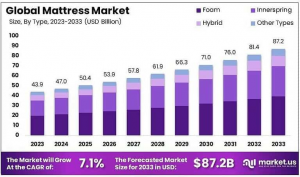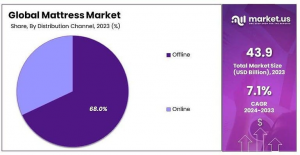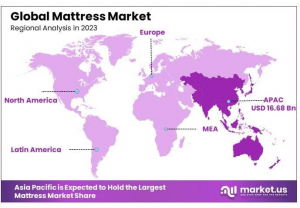The Global Mattress Market size is expected to be worth around USD 87.2 Billion by 2033, from USD 43.9 Billion in 2023, growing at a CAGR of 7.1%.
Asia Pacific leads the Mattress Market with 38% share, valued at USD 16.68 billion, driven by urban growth, rising incomes, and sleep health awareness.”
NEW YORK, NY, UNITED STATES, January 22, 2025 /EINPresswire.com/ -- Market Overview— Tajammul Pangarkar
The Global Mattress Market size is expected to be worth around USD 87.2 Billion by 2033, from USD 43.9 Billion in 2023, growing at a CAGR of 7.1% during the forecast period from 2024 to 2033.
The mattress market refers to the global industry dedicated to the manufacturing, distribution, and retail of bedding products, particularly mattresses. This market includes various types of mattresses, such as innerspring, foam, hybrid, and memory foam, among others.
The demand for mattresses is driven by growing awareness of health and wellness, changes in consumer preferences, and increased disposable incomes, which fuel the need for better sleep solutions. With the rise of e-commerce, mattress sales have significantly shifted online, offering opportunities for brands to reach a broader consumer base.
The global mattress market has witnessed steady growth, primarily driven by increasing consumer awareness of the importance of sleep quality. Rising disposable incomes in developing economies and an aging population in developed regions are key factors contributing to this growth. The demand for eco-friendly and sustainable products is on the rise, presenting opportunities for innovation in material usage and manufacturing processes.
Governments are also investing in healthcare initiatives, which indirectly support the demand for quality sleep solutions. Regulations regarding product safety, such as fire resistance standards, continue to play a crucial role in shaping the industry, as manufacturers must ensure their products comply with regional safety regulations.
For new players entering the mattress market, this report provides valuable insights into consumer preferences and emerging trends, such as the shift towards online sales and sustainable materials. Understanding these factors will be crucial in developing competitive strategies to capture market share.
Existing players can benefit from the data on market dynamics and growth segments to refine their product offerings and expand into new geographical areas. In addition, by focusing on sustainability and innovation, both new and established players can align themselves with evolving consumer preferences and regulatory requirements, ensuring long-term success.
Curious About Market Trends? Request Your Complimentary Sample Report Today: https://market.us/report/mattress-market/free-sample/
Key Takeaway
- Mattress Market was valued at USD 43.9 Billion in 2023, and is expected to reach USD 87.2 Billion by 2033, with a CAGR of 7.1%.
- In 2023, Foam mattresses led the market with 45%, due to their comfort and ability to conform to body shapes.
- In 2023, Household use dominated the end-use segment with 78%, driven by increased focus on home comfort and sleep quality.
- In 2023, Offline distribution led with 68%, as many consumers prefer to test mattresses before purchase.
- In 2023, Asia-Pacific led the market with 38% share and USD 16.68 Billion, driven by increasing urbanization and disposable incomes.
Driving Factors
Rising Consumer Awareness on Sleep Health: As people become more aware of the importance of quality sleep for overall health, they are more willing to invest in high-quality mattresses. This growing awareness drives demand for mattresses that offer better comfort and support.
Increasing Disposable Income: As disposable incomes rise globally, particularly in emerging markets, consumers are increasingly able to spend on premium mattresses. This boosts sales of higher-end products, especially those that offer specialized features like memory foam or hybrid designs.
Technological Advancements in Mattress Design: Innovations in mattress technology, such as memory foam, cooling fabrics, and adjustable firmness, are attracting customers who seek a personalized sleep experience. These advancements make mattresses more appealing, especially in the premium market.
Growth in E-Commerce: The rise of online mattress retailers like Casper and Purple has revolutionized the mattress market. Consumers can now conveniently shop for a variety of mattresses from their homes, often with trial periods and free delivery, which has contributed to the market's growth.
Increased Focus on Sustainability: Consumers are increasingly looking for eco-friendly mattresses made from sustainable materials. Brands that offer biodegradable or organic mattresses are benefiting from the growing trend toward sustainable living and environmentally conscious buying decisions.
Restraining Factors
Increasing Raw Material Costs: The price of raw materials used in mattress manufacturing, like memory foam, latex, and cotton, has been rising. This directly affects the overall cost of production, forcing companies to either absorb the cost or pass it onto consumers, which could lead to lower demand.
Stiff Competition from Online Marketplaces: The rise of online mattress retailers, offering direct-to-consumer sales, has increased competition. Many traditional mattress stores are facing pressure as consumers shift towards online shopping for better prices, convenience, and the ease of home delivery.
Saturation in Developed Markets: In developed regions like North America and Europe, the mattress market is reaching saturation. Most people already own a mattress, and with the average replacement cycle being around 7–10 years, growth potential in these markets is limited, making it harder for companies to find new customers.
Report Segmentation
The mattress market is divided into types, end-uses, and distribution channels. Foam mattresses lead the market with a 45% share, offering comfort and support through body-contouring materials. The household segment dominates the market, accounting for 78% due to growing demand for quality sleep and wellness. Most mattresses are still sold through offline channels, which hold 68% of the market, as consumers prefer testing mattresses in-store before buying.
By Type
Innerspring
Foam
Hybrid
Other Types
By End-Use
Household
Commercial
By Distribution Channel
Offline
Online
Use Cases
1. E-commerce Mattress Sales: With the rise of online shopping, mattress brands are increasingly selling directly to consumers through their websites and platforms like Amazon. By offering convenient delivery options, hassle-free returns, and various promotions, e-commerce companies can reach a wider customer base, tapping into the growing preference for online shopping.
2. Smart Mattresses for Health-Conscious Consumers: The demand for smart mattresses is rising. These mattresses come equipped with sensors that track sleep patterns, body temperature, and even heart rate. Health-conscious consumers are drawn to these products as they seek better sleep quality and wellness features. The smart mattress market is especially popular among tech-savvy, health-focused individuals.
3. Sustainably Sourced Mattresses: As consumers become more environmentally conscious, mattresses made from organic or sustainable materials are gaining traction. Companies that focus on eco-friendly manufacturing processes and materials, such as natural latex or bamboo fabric, cater to the growing market segment of eco-conscious buyers.
4. Luxury Mattresses for Premium Customers: High-end, luxury mattresses are popular among consumers willing to spend more for premium features such as top-quality materials, customized firmness, and long-lasting durability. This segment targets individuals seeking exceptional comfort and sleep experiences.
5. Affordable Budget-Friendly Mattresses: Budget-conscious buyers often seek cost-effective mattress options. Affordable mattresses with decent comfort and quality are essential for this market segment, particularly among first-time mattress buyers or people moving into new homes.
Ready to Act on Market Opportunities? Buy Your Report Now and Get 30% off: https://market.us/purchase-report/?report_id=14885
Regional Analysis
Asia Pacific is the leading region in the Mattress Market, holding 38% of the market share, valued at USD 16.68 billion. This strong position is driven by factors like rapid urban growth, increasing disposable incomes, and a rising focus on sleep health. Countries such as China, India, and Japan are seeing high demand for mattresses as more people in these regions invest in home comfort products due to population growth and an expanding middle class.
The region also benefits from large-scale manufacturing and cost-efficient production, helping local companies meet the growing demand. Additionally, the growth in the real estate and hospitality industries in major cities boosts mattress sales. The rise of e-commerce platforms also makes it easier for more people to buy mattresses.
Key Players Analysis
The mattress market is segmented by type, including innerspring, foam, hybrid, and other types. Foam mattresses are the leading sub-segment, capturing a 45% market share. This dominance is largely due to the high level of comfort and support provided by foam materials, which adapt to the shape of the body, offering effective pressure relief and spinal alignment.
The mattress market is segmented by end-use into household and commercial. The household segment dominates, accounting for 78% of the market. This is largely due to the increasing consumer demand for high-quality sleep experiences and the rising importance of health and well-being in residential settings.
The mattress market is segmented by distribution channels into offline and online. Offline channels are predominant, holding a 68% share, as many consumers prefer to test mattresses in-store before making a purchase. This preference stems from the desire to physically experience the comfort, firmness, and texture of a mattress, which are critical factors in the decision-making process. Retail stores also offer the advantage of immediate customer service and the possibility to negotiate prices or obtain financing options.
Top Key players:
Tempur Sealy International Inc.
Serta Simmons Bedding LLC
Spring Air International
Sleep Number Corp.
Kingsdown Inc.
Southerland Sleep
Boll & Branch
Casper Sleep Inc.
Purple Innovation LLC
Simmons Bedding Company LLC
Relyon Ltd.
Other Key Players
Not Sure? Request a Sample Report and See How Our Insights Can Drive Your Business: https://market.us/report/mattress-market/free-sample/
Growth Opportunities
Eco-Friendly and Sustainable Materials: Consumers are becoming more environmentally conscious, and there's a growing demand for mattresses made from eco-friendly materials. Offering mattresses made from natural latex, organic cotton, or recyclable materials can appeal to this market segment and tap into the sustainability trend.
Smart Mattresses with Technology Integration: The increasing interest in health and wellness presents an opportunity to introduce smart mattresses equipped with sensors to track sleep patterns, adjust firmness, and improve sleep quality. These mattresses could sync with other smart home devices to enhance the user experience.
Growth in E-Commerce Sales: Online mattress sales have surged in recent years, as customers value the convenience of home delivery and the ability to test mattresses through trial periods. Expanding direct-to-consumer sales through online platforms or launching subscription services for regular mattress replacements can provide strong growth potential.
Premium and Customizable Mattresses: As disposable income rises in various regions, consumers are willing to spend more on high-end, personalized mattresses that cater to their specific needs. Offering customization options like adjustable firmness, cooling technology, or memory foam layers could attract a more affluent customer base.
Expansion into Emerging Markets: As developing economies experience growth in disposable income and urbanization, there is an increased demand for quality mattresses. Expanding into emerging markets, especially in regions like Asia-Pacific and Latin America, can offer significant revenue growth for mattress manufacturers.
Trending Factors
Increased Demand for Online Sales: Consumers are increasingly purchasing mattresses online due to the convenience of shopping from home and easy return policies. E-commerce platforms and direct-to-consumer brands are gaining popularity in the mattress market.
Rise in Health Consciousness: As people become more health-conscious, there’s a growing demand for mattresses that provide better support for sleep, such as memory foam, hybrid mattresses, and mattresses designed for spine alignment.
Sustainability and Eco-Friendly Products: Eco-conscious consumers are pushing for mattresses made from sustainable and non-toxic materials. Brands are incorporating organic cotton, bamboo, and natural latex, as well as offering recyclable mattresses to cater to the environmentally aware segment.
Smart Mattresses with Technology Integration: Smart mattresses, equipped with features like sleep tracking, temperature control, and adjustable firmness, are gaining traction. These innovations aim to improve sleep quality and cater to the tech-savvy, comfort-seeking consumer.
Rising Disposable Income in Emerging Markets: As disposable incomes rise in emerging markets, particularly in Asia-Pacific regions, there’s a growing demand for premium mattresses. Consumers in these regions are increasingly investing in higher-quality products for better sleep experiences.
Lawrence John
Prudour
+91 91308 55334
Lawrence@prudour.com
Visit us on social media:
Facebook
LinkedIn
Legal Disclaimer:
EIN Presswire provides this news content "as is" without warranty of any kind. We do not accept any responsibility or liability for the accuracy, content, images, videos, licenses, completeness, legality, or reliability of the information contained in this article. If you have any complaints or copyright issues related to this article, kindly contact the author above.




